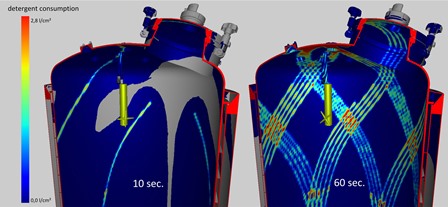We know it from our own homes: bulky kitchen utensils and appliances are difficult to clean. In industry, complex components are more the rule than the exception and present big challenges for the design of cleaning systems. A simulation will be able to help in the future. In the Learning Factory for Industrial Cleaning Technologies, which will open at the end of 2019 at the Fraunhofer Institute for Process Engineering and Packaging IVV in Dresden, companies will also be able to test the combination of various cleaning technologies.

When components roll off the line, they are often covered with cooling lubricants. Frequently, these lubricants have to be removed before the parts can go for further processing. With complex components, however, this is far from easy. Based on his or her experience, the responsible engineer must decide how to position the nozzles of the spray cleaning system. Where is there a drill hole? Where is there an undercut on the component? In elaborate test systems, he or she checks whether the nozzles achieve the required cleaning performance and adapts and rebuilds accordingly – a costly and time-consuming process.
Setting up spray cleaning systems
In the future, this task will be made easier thanks to simulation software developed by researchers from the Fraunhofer Institute for Process Engineering and Packaging IVV in Dresden together with partners Advitec Informatik GmbH and Innovations- und Simulationsservice Festenberg in the SIMKOR project, which is sponsored by the German Federal Ministry of Education and Research (BMBF). “The software delivers results for spatially resolved cleaning performance in just a few minutes, even for complex components,” says Siegfried Beckmann, research fellow at Fraunhofer IVV. Instead of relying on experience alone, the engineer loads the CAD data of the object to be cleaned into the software and selects and places nozzles. In a pre-optimization step, he/she can see in real time which areas the cleaning agent reaches directly and which it does not. After selecting a good position for the nozzles in this way, the engineer starts the simulation. This supplies even more detailed results, such as the spatially and time-resolved distribution of the quantity of cleaning agent applied and a simulation of the theoretical cleaning effectiveness. “Color coding indicates where the cleaning is more effective and where less. This allows users to realistically appraise problem areas independently of the type of soiling or surface quality,” explains Beckmann.
To create the simulation tool, the researchers at Fraunhofer IVV carried out various cleaning experiments with standard (i.e. average) levels of soiling. They analyzed the cleaning results for numerous nozzle positions and jet angles. “We treated the nozzles as the cause and the events on the surface as the effect. We deliberately bracketed out everything in between, as these processes were far too complex for the simulation. So we chose a statistical simulation approach,” says Beckmann. Out of this data, the partners then created the corresponding mathematical models for the simulation.
The first test version is already finished; in spring 2019, the partners will bring the simulation software onto the market. In the future, the simulation might even be able to specify optimum nozzle positions or suggest the optimum cleaning paths so as to maximize the resource and energy efficiency of the cleaning process – that is the vision.
Learning Factory for Industrial Cleaning Technologies
What cleaning process is optimal for a specific component? Does the selected cleaning process achieve the desired result? These questions are often difficult to answer for users of cleaning technology. This applies especially to small and medium-sized businesses, of which there are many in Saxony. The researchers at Fraunhofer IVV also have the right solution for these SMEs: the Learning Factory. “There we combine established water-based techniques – i.e. spraying, immersion cleaning, ultrasound and the cleaning of closed pipeline and tank systems – with newer methods such as atmospheric-pressure plasma, dry steam and CO2 and laser cleaning,” explains Markus Windisch, Team Leader for Industrial Component Cleaning at IVV. “Together with the customer, we begin by devising a solution for the particular application and then we test it in the Learning Factory.” In a nutshell: the Learning Factory is a platform that enables companies to try out various cleaning techniques – and particularly different combinations thereof – in a secure environment. Once they find the optimum cleaning solution, companies can retrofit accordingly and give their workers suitable training in the Learning Factory even before commissioning. “We deliberately used commercially available devices and hardware, so that we could offer practical solutions,” says Windisch.
The researchers also take into account Industrie 4.0 and digitalization in the Learning Factory. For example, they integrated a system solution that records the process data – whether it comes from the machines themselves or is entered manually by the operator. Instead of putting up sticky notes with instructions all over the machine, as has been the practice in many factories, workers can enter their comments directly in the system using a tablet computer and share them with their colleagues in this way – even those working at other plants.
Some of the techniques are already up and running, and initial customer inquiries have come in also. Nevertheless, it will take some time before the cleaning of complex components and the combination of various cleaning techniques can be tested – that requires a second robot system. At the end of 2019 it should be ready. At that stage, the Learning Factory will also encompass skills training for customers’ employees. Topics addressed will include: How does the mangement of a quality-controlled cleaning process differ from that of a time-controlled cleaning process? On March 14, 2019, a project workshop will be held in cooperation with the Saxony Economic Development Corporation (WFS) – an industry event with a focus on cleaning quality.